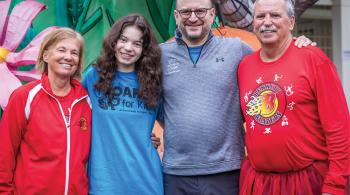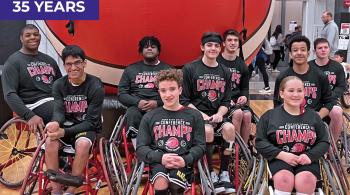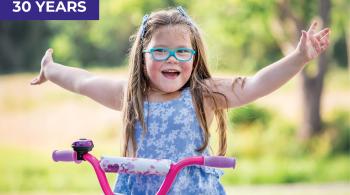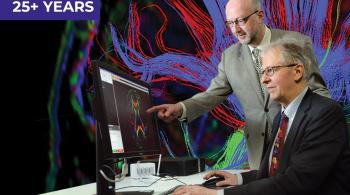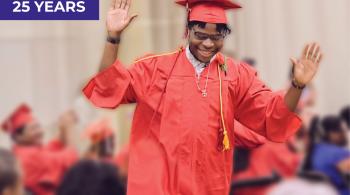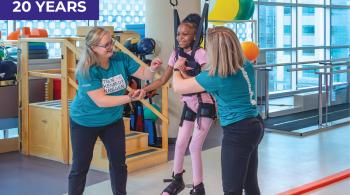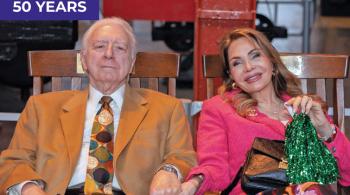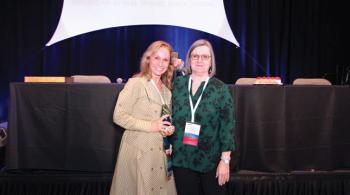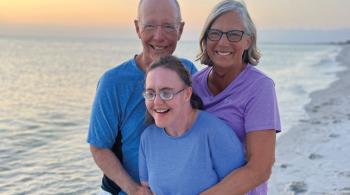Adaptive Sports
On this month's episode of Your Child's Brain, adaptive sports and their physical, mental and community benefits are discussed.
Speakers include:
- Dr. Erin Michael, a physical therapist, is the manager of patient advocacy and special programs at Kennedy Krieger Institute’s International Center for Spinal Cord Injury. She is also the founder and chair of Team Kennedy Krieger for the Baltimore Running Festival and other adaptive sports competitions.
- Katie Baldwin, MS an exercise scientist with expertise in Community Physical Activity, is the supervisor of Kennedy Krieger’s Adaptive Sports Program and specializes in spinal cord injury rehabilitation at our Spinal Cord Center.
- Daniel Romanchuk, native of Mt. Airy, Maryland, is a two-time Paralympian (2016 and 2020), Gold and Bronze Medalist, world record holder, champion of multiple high profile marathons (like Chicago, Boston, London). Daniel is an advocate for individuals with disabilities.
- Dr. Kim Romanchuk, Daniel’s mom and manager, a physician and science educator.
Resources:
- MoveUnitedsport.org
- Adaptive Sports for Children
- Adaptive Sports for Adults
- Kennedy Krieger Baltimore Marathon
View Episode Transcription
Dr. Brad Schlaggar (BS): Welcome to Your Child's Brain, a podcast series produced by Kennedy Krieger Institute with assistance from WYPR. I'm Dr. Brad Schlaggar, pediatric neurologist and president and CEO of Kennedy Krieger Institute. This month, we're discussing adaptive sports and their physical, mental, and community benefits. I'm pleased to be joined today by my colleagues from Kennedy Krieger, Dr. Erin Michael, and Katie Baldwin. Dr. Michael, a physical therapist is the manager of Patient Advocacy and Special Programs at Kennedy Krieger's International Center for Spinal Cord Injury. She's also the founder and chair Team Kennedy Krieger for the Baltimore Running Festival and other adaptive sports competitions. Katie Baldwin, an exercise scientist with expertise in community physical activity, is the supervisor of Kennedy Krieger's Adaptive Sports Program and specializes in spinal cord injury rehabilitation at our Spinal Cord Center. I'm really excited to introduce our special guests, Daniel Romanchuk, native of Mount Airy, Maryland, is a two-time Paralympian, 2016 and '20, gold and bronze medalist, world record holder, champion of multiple high-profile marathons, Chicago, Boston, London, and an advocate for individuals with disabilities. Also joining us today is Daniel's mom and manager, Dr. Kim Romanchuk, a physician and science educator. I should also say that Daniel has strong ties to Kennedy Krieger as he is a former member of the Bennett Blazers, which is an adaptive sports program for children and teens at Kennedy Krieger Institute that is led by a husband and wife team, the incomparable Gerry and Gwena Herman. Welcome Erin, Katie, Daniel, and Kim. Katie, let's start with some definitions. What is meant by adaptive sports and what are some examples of adaptive sports?
Katie Baldwin (KB): Adaptive sports are basically all sports that are modified to allow people with physical and sometimes mental disability to participate.
BS: Some examples of the types of adaptive sports that you interact with?
KB: Yeah. There are some outdoor recreational activities such as kayaking or fishing, sometimes snow skiing. There's some performing arts activities, such as dance. You can do individual sports such as wheelchair racing or hand cycling. Then there's team sports such as basketball, rugby, sled hockey.
BS: It really covers the waterfront of sports and sports types of activities that we think of. Erin, you've been helping individuals with disabilities get involved with adaptive sports for much of your career. From a clinical, medical, social perspective, what do you see as the value of participating in these activities whether in elite competition or recreation and fitness?
Dr. Erin Michael (EM): I think the list is so extensive, it's hard, but I'm going to try to be concise. From a physical standpoint, you've got improved strength and endurance, decreased risk of cardiovascular disease, enhanced sleep, increased aerobic capacity. The list goes on and these things all lead to overall improved functional independence, so better transfers, better ability to move in their wheelchairs, and so on. The social benefits are also far-reaching. There's enhanced quality of life, decreased symptoms of anxiety and depression, improved coping after their diagnosis. Most importantly, even camaraderie or a better sense of belonging. Our athletes feel less alone and have opportunities to learn from one another. There becomes a mentorship component. We had one of our trips that we went on. One of our patients was having trouble transferring in and out of bed on her own and she had been working on in therapy. But lo and behold, one of our fellow athletes on the trip was able to teach her the most effective way to transfer in and out of bed. She's been able to be independent with that since that trip. Sports are fun. They promote pleasure in the day-to-day and then they lead to improve self-confidence. The one thing that I personally love about adaptive sports is the focus on what the athlete can do versus what they can't. I know many of our athletes report to us consistently that they hear from other providers or other people in the community so often of what they're not capable of and participating in adaptive sports or recreation, they just learn how capable they truly are.
BS: It's really a compelling argument for participation in sports. Again, whether it's at the elite level or for recreation and fun, so many benefits that are both straightforward and predictable, but just as you're describing unanticipated, which really enriches the experience. Daniel, speaking of elite athletes, you are a champion many times over in wheelchair racing. Can you tell us how you got your start with adaptive sports and what sport did you play? Did you play many different sports and then hone in on wheelchair racing? What was that pathway like for you?
Daniel Romanchuk (DR): Yeah. My parents had heard about the Bennett Blazers program from another family just before I had turned two years old and actually, Bennett starts taking kids at two years old and so as soon as I was two, I was there. Those first few years, it was basically motor development and so just them teaching us how to use our bodies to reach our goals. It was just a lot of fun. Maybe it was balancing on a big exercise ball and throwing another ball at some pins, knocking them down, or playing games in the pool and just things like that. But as we got older, you get into more organized sports. I was swimming independently at three years old. I was playing wheelchair basketball and racing at four and at five, I was playing sled hockey, and all the other sports that they had offered pretty much all the way through 18 years old when I aged out. I started to focus on wheelchair racing when I was around 16 years old. Long story short, I basically had decided that I wanted to try and make the real Paralympic Games. But as I mentioned, I still continued to play all of the other sports as much as I could.
BS: Yeah, it's an important lesson in youth sports in general. Having an array of different types of athletic opportunities makes you a better athlete overall. I suspect it helped with your successes in wheelchair racing. When you look back, what value do you think that participating in adaptive sports has had for you personally beyond the immediate competition?
DR: It's really hard to really sum everything up. I think touching back to something that Erin had said, Bennett's motto is teach kids they can before someone tells them they can't. That was really a part of everything they did. They taught us to focus on what we did have and not on what we didn't have or what didn't work. It was never an acceptable excuse to say that I can't do something because my legs don't work. I think that's a really important life lesson in general. I never thought about my disability as an obstacle or that I was supposed to be limited by it. It always confused me when I heard people talking about how inspiring I was, seeing me playing sports and stuff like that. I think just being raised in that, I can, atmosphere I never realized that there were supposed to be limits that I was pushing or obstacles that I was overcoming. I was just being a kid, doing what I wanted to do, and go and where I wanted to go. Now, I travel the world as a professional wheelchair racer and adaptive sports not only allows me to support myself, but it's also given me a platform to advocate for and support the disability community as a whole. I don t think it's an overstatement at all to say that adaptive sports really changed my life.
BS: It's hard to say anything other than that it's just such an exceptionally clear and important message. Kim when you look back do you remember your thought process why you got Daniel involved in adaptive sports in the first place, and what were your expectations and/or concerns and how do you think he's benefited?
Dr. Kim Romanchuk (KR): We had two other kids that were older and they had played sports from a young age. I guess we never really figured there was a reason why Daniel should do anything differently. We weren't sure how and that's why we were really excited when we found out that there was this adaptive sports program Bennett that he could go to. Because it did seem a little overwhelming, all the different things that we just didn't know anything about any of the stuff. I don't think we had any expectations really other than he was going to have fun hopefully stay fit. We knew some of the more medical stuff about spina bifida, that being physically active was going to be important for him. But I don't even know if we knew the Paralympics existed at that point, so certainly that level wasn't on our minds. Concerns I'd say [LAUGHTER] that I do remember when Daniel was maybe four or five years started to play wheelchair basketball. We would watch the teenagers play and watching them just crashing into each other and going flying to the floor and everything chairs and all and I'm like, oh. That did get my attention a little bit but then I really thought about that's what our other kids do and Daniel again just didn't need to be any different that way. I think the first time I saw a wheelchair racing crash we said, Oh, wow. He was going really fast and they're just flying like dominos [LAUGHTER] but you know what? Daniel was an athlete and we had to really resist the temptation to wrap him in swaddling and keep him "Safe". We were really happy that Bennett treated him like an athlete and they didn't take any excuses or anything along those lines. I think that just putting that bar high and knowing what was possible and not making limits or challenges like the routine focus, was really important in shaping how Daniel thinks of himself and that's what I see as the biggest benefit.
BS: With your experience that you just described so well, what advice do you give to other parents who are thinking about getting their kids into adaptive sports programs, and may have similar concerns when they see the crushing of wheelchairs whether on the race track or on the basketball court?
KR: I think if you know that adaptive sports exist you've already done the hardest. That's the hardest thing as we hear from many families. Their kids are teens by this point they've had a disability since they were born and they didn't know it existed. When you know it exists you got to finding a program that's really helpful. I think maybe we'll get a chance to talk about some of the ways you can look for that some things online for finding a program. But I think the biggest thing is just do it and do it now. I think the younger that the kids start in adaptive sports and they're immersed in that I can mentality the better. It's not just for kids who really loves sports or that kind of thing. I remember at Bennett and I'm sure it's this way at adaptive programs across the country. Gerry and Gwena were to pay just as much attention to a kid who would struggle to catch a basketball as the kid who could hit three-pointers all day long. It's not all about your sports ability, it's about that camaraderie that is there and learning from each other. I think another thing is it's not just about wheelchair sports, and it's not just about people who use a chair in everyday life. That's a big misconception that people have to get past people who have amputations or limb differences, visual impairments, all of those. There are sports for all of those different types of disabilities and sometimes it involves getting in a chair, even if you don't use one in everyday life and it's really some of our most accomplished paralympians. There was this long process of getting them even to try a wheelchair sport, but now they're competing on the biggest stage in the world. Just get in there and do it. Let them fail, let them get frustrated and be a kid.
BS: Excellent. Again the Gerry and Gwena that Kim just mentioned again, that's Gerry and Gwena Herman who lead the Bennett Blazers program, The Bennett Institute at Kennedy Krieger Institute. So Katie what questions do people usually have building on the advice that Kim just described, what questions usually you hear from people about adaptive sports. What kinds of concerns do you hear about prior to a participation?
KB: Two of the first questions always asked, are cost. How much does this cost? Can I afford it? Going into the equipment, the equipment is expensive. How am I going to get this for myself? How can I sustain this activity? Another question is accessibility. How am I actually going to do this? Is it possible? There's so many people that have never tried it and they're intrigued and they're like, there's no way I can get into a hand cycle or no way I can get into a kayak and go paddling on the water. Those are the two biggest questions which turn into concerns for a lot of our participants that we see in the community. Then off of that is we get a lot of people who are looking for these resources where they live. Kennedy Krieger, we see many patients from around the world, and yes, we offer these activities and events locally here, but they want to continue to do it at home. So how do they find it? How do they do these things at home? How they continue?
BS: Kim, you made the point that when Daniel started just getting involved in sports, the other older siblings got involved. Before your eyes emerged a world-class athlete, at what point did you recognize that Daniel had that potential and how did you rearrange your expectations to facilitate making that happen?
KR: I think pretty early on it was clear that Daniel was just a coordinated kid. Yes, his legs did not work typically, but you could tell him to do something and he can replicate that motion pretty early on, so whatever that's worth. [LAUGHTER] But he also had a really good work ethic, you would tell him to do something, Gerry and Gwena, especially if it came from his coaches, maybe not so much us, [LAUGHTER] and he would do it to the T, sometimes very literally and no shortcuts involved. I remember one time, I think they were doing strength conditioning and Jerry told the kids to do dips, just do as many dips as they could, and he forgot Daniel was listening to this, and so the other kids are smart and they stopped when it starts to really hurt and stuff, and Daniel just keeps going until he physically could not move anymore. I think the next day they had a sled hockey game and Daniel couldn't move at the elbow. [LAUGHTER] So Gerry is like, "Yeah, that one backfired on me." But, it wasn't ever until probably his mid-teens. It wasn't ever something that we made it a goal. It was just give the opportunities there. There's so many different sports to try, try them all, and then once he did decide and he made that decision that he wanted to go for that, the Paralympics, then a lot of rearranging had to be done. But that wasn't until he was mid-teens.
BS: Daniel, I think most of our listeners and everybody on this call, we can say that we're not really elite athletes. So can you tell us what it's like? What's the experience? What's your training schedule like? Nutrition, preparation, and what does it feel like to be able to compete on the world stage?
DR: There's a lot, so I basically train 1-2 times a day for about an hour or an hour-and-a-half each time and year-round, most of the time we train that out on the road or on a track. But in the winter, we're inside on the rollers, which are basically our version of a treadmill, and we also do a little bit of strength work in the gym but it's mostly bodyweight stuff. Just because of the nature of our sports, we need to maintain a lot of flexibility in our shoulders, so we don't want to bulk up too much, and yeah, I certainly do have to keep up a pretty close eye on my nutrition so that my body has the fuel it needs, but not so much that I don't fit in my racing chair, there's not too much forgiveness in aluminum and so I'm on the road traveling at least 1/3 of the year. Learning how to travel while using a wheelchair and having to keep in mind medical things, it's been a big process. But yeah, as far as competing on a world stage, I actually try not to think about that too much. I basically whenever I find myself into deep at thinking about that, I just remind myself it's another 400-meter track, just like the one that I trained on at home, and at that point, I've done all the preparation so just go out there and race. But of course, it is a huge honor to be able to represent the United States at the stages such as the Paralympic Games. It's an amazing experience.
BS: Knowing a bit about you, know that you're very much involved in mentorship and venturing young athletes, can you tell us a bit about that and why you got involved in that part of your experience?
DR: Yeah. One of the coolest things about Bennett was that people who had gone through the program and aged out, they came back to the program and they taught us about how to play sports. But really it was also just what we saw them having done. Some of them had gone to the Paralympic Games but they had gone to college on a scholarship for athletics, and they had gotten a degree, gotten a job, had gotten married, and had family, so just leading a normal life. We saw that and figured our future is going to be no different. I've been trying to just continue that, trying to get back to Bennett whenever I can or just other adaptive sports program around the country and try and work with the athletes. I've been making videos to try and help people just know how to take care of their equipment as Katie had said, the equipment is a lot to work with in maintenance, and where do you get it, and all of that stuff. I've also traveled to some junior competitions to help mentor the younger athletes and especially those who might not have a local program that they can help them learn.
BS: Well, one of the things we can do for this podcast is put links to some of those resources that you just described, Daniel, that would be great. Are kids who get involved in adaptive sports able to compete in school, at the high school or collegiate level? What obstacles are there for participation?
EM: I'm hoping Daniel and Kim can fill in some of the spots here that I might miss. But I know for the high school student, many of them compete alongside their able-bodied classmates or peers or they participate in programs outside of their schools such as the Bennett program. Many of the sports or activities offered at the high school level are really only I think the only sports are really that are offered are track and field. I don't think there's really any competitive like wheelchair basketball or any of that type of team sports for children in high school. I know for the college student, there's only a handful of colleges that offer adaptive programs for athletes. So it's pretty tough to find where they want to go and things like that, but they do exist. So definitely having those resources and knowing what does exist is important. Some of the biggest obstacles for this is funding, high schools, for instance, might not have the funding to create a program or a college to create a program, the equipment, programming somebody who's familiar with adaptive sports or has the experience or knowledge of how to run this type of program. Then accessibility, again, just accessing the environment.
BS: If a parent wants to help their child to get involved, Katie, where might they go for more information, again, for opportunities and equipment and we can put this on the podcast website as well.
KB: Yeah. One of the ones that I refer a lot of our patients or parents to is Move United. They're an excellent resource as far as finding locations where adaptive sports exist. Grants that exist, equipment needed, rules, regulations, that kind of thing. I find Move United is very resourceful in that realm.
BS: Kim, Daniel, do you want to comment?
KR: Yeah. Just to jump in here a little bit with the high school sports. For sure most states have it's individually regulated by each state whether an athlete can compete for their school or not. Indeed, absolutely, track and field is the biggest one. I've also heard of some states that have swimming in other individuals for it, that they can participate, potentially earn points for their teams, that kind of stuff. I think one of the biggest barriers there is getting education for the coaches who are maybe very willing, but just lack the resources, and so that's where a lot of the programs located across the country like Bennett or Great Lakes, it has a great program. Those coaches oftentimes will act as resources for the high school level coaches to say, hey, you know, what should a workout look like? Really, I think you'll find that the adaptive sport community is just incredible at jumping in and helping people. It might be your competitor, but that doesn't matter. They see the bigger picture better. In colleges the number is growing as far as the number of universities that are offering adaptive sports and absolutely there are scholarships available and more readily available than you might think. So it's definitely something to get in there and do some research.
BS: Erin, I know that some of the athletes in your program who have spinal cord injuries travel all over to compete. What are some of the clinical and medical concerns or considerations that you have to take into account for safety and travel?
EM: I think one of the big ones is the equipment. Unfortunately, the reality is that there's a significant risk for damage to personal or medical equipment while traveling. We've seen parts of wheelchairs go missing or a wheelchair malfunctioning completely after travel. We highly suggest connecting with a supplier or the equipment manufacturing rep, local to your travel destination prior to travel, that helps ensure that you have someone on the ground that can help with any damaged equipment and maybe keep the functional wherever you're going. Skin is another big one. Changes in circulation, tissue strength, and muscle mass cause many of our athletes to have a higher risk for skin breakdown or wounds. It's important to be thorough with skin checks and performance of pressure reliefs while you're traveling. Often, the athlete is not using their prescribed wheelchair, and the seats on planes or trains can be pretty unforgiving. So keeping track of skin is the big one. Another one with air travel, blood clots. Many of our athletes are at higher risk for blood clots in general because of changes in circulation and mobility, and then there's the heightened risk while you're in the air. So being aware of signs and symptoms of a clot and talking to your doctor prior to traveling. Medications. Knowing what you can carry on your person, researching if medications that you're taking are legal at your different destinations. Especially lately, we've seen more and more delays and unforeseen circumstances in travel, so trying to prepare as best you can. Another big one is the accessibility at the destination, the hotels or rental property, the businesses and public spaces that you're going to be accessing. We have learned that accessible means different things at different places. So we find it best to ask very specific questions, especially regarding places where you're planning to stay. So really getting the details, for example, of what the bathroom looks like. If you're a wheelchair athlete, if your wheelchair can actually fit into the bathroom. Then service animals. We haven't traveled outside of the US for any of our trips so far. But it is important to note that different countries have different policies on service animals. So if traveling with one, you want to know those guidelines ahead of time. Then I think my biggest piece of advice is to manage expectations. It is highly likely that something's not going to go as planned, and so we've adapted to taking our travel snafus as learning opportunities and when appropriate as a chance to educate the greater community about people with disabilities.
BS: So, Erin, let's talk about competitions including one that's very near and dear to our hearts and that's the Baltimore Running Festival. Where and when and how does that competition and others like it work?
EM: Yeah. This is a tough one to generalize because it really does depend on the type of activity we're discussing. Between Bennett Blazers and Team Kennedy Krieger, there are a variety of activities occurring all throughout the year and in different parts of the country. We do keep an updated list of activities on our website and we consistently post opportunities for Team Kennedy Krieger in our private Facebook group, which is Team Kennedy Krieger, Adaptive Sports. As far as Team Kennedy Krieger or Bennett Blazer activities, their stuff being posted on our website. The important thing to know is that for a Kennedy Krieger sponsored event, there will be staff members or volunteers present to guide the athlete through the process. So there's somebody there to support you. Regarding the Baltimore Running Festival that's occurring right here in Baltimore City on October 15th, Team Kennedy Krieger is a charity team in the event. We have adaptive athletes hand cycling the full marathon and then walking or pushing in the 5K, our hand cyclists each get a bike escort on the course to ensure their safety and their visibility. Our 5K participants get an escort, often even a whole crew, to navigate the course with them. So you truly are not alone when you're on this team. We have a team tent in the charity village and we meet there in the wee hours of the morning before the race for coffee and pep talks, and the races all have different start times. So we typically have a convoy that goes off to each start line up. So again, not alone, and once our athletes cross the finish line, they can come back to the team tent, and we can all celebrate the accomplishments together. I think there are two big things I'd like to note about this event. Team, Kennedy Krieger welcomes participants without a disability to join us at any distance. So come on out and run or walk with us and this is our primary fundraiser which allows us to maintain our extensive programming throughout the year. So without this event, there is no team.
BS: Come on out and support the Baltimore Running Festival. It's really an outstanding event. Even if you're not participating as an athlete, it's energizing to be out there. [MUSIC] So thank you so much to this month's guest for the lively discussion about adaptive sports. We hope all of you listening and have enjoyed the discussion as much as we have. We hope you'll share this podcast with your friends and consider rating it as well. We invite you to check out our entire podcast library at WYPR.org/YCB, KennedyKrieger.org/YCB, WYPR.org/studios, or wherever you get your podcasts.

